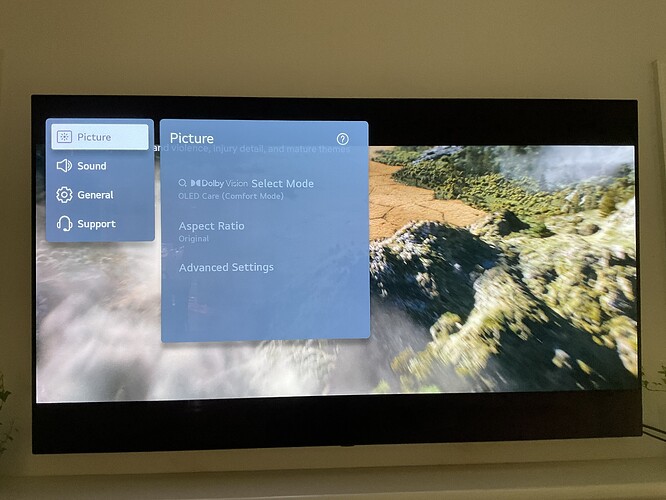OK, I have one possible answer, and that is that the software is working (or broken) as designed. Given that there is no distortion to circles, what you’re seeing is correct display of a picture that is wider than 16x9 (or 1.78:1 in film terms), and that is being shown in intended format.
Some quick background, and then a suggestion.
The 16x9 aspect ratio for HD-TV was picked for technical reasons associated with television, and is close enough to film widescreen (1.85:1) that side cropping loses little. Therefore everyone crops so that you see a full-frame image from widescreen material re-mastered to be shown on TV sets.
Cinemascope is substantially wider at 2.55:1, and while you could just side-crop that (pillar-boxing) the results would displease almost everyone. Generally therefore, widescreen content is mastered to be letterboxed, and that’s regarded by the industry as best compromise. And given the shift towards really big screens (even a 66" screen is spectacularly big at typical viewing distances) the black bars at top and bottom should have little effect on viewing satisfaction. Way less impact than if the sides were cropped, for instance.
For technical readers, there’s another completely separate discussion about whether the image pixels are square or rectangular and that’s outside this discussion. What’s really important is that the display parameters of the player client and the display parameters of the TV match in a way that leaves the picture undistorted. In this case, if circles are indeed displayed as circular, that’s happened. Your screengrab has no circles in the image, but it does look like it’s correct aspect ratio all round (including the menu).
There are two places where display could be changed. One is in the software of the display client - eg, your Netflix software. The other place is in the TV set itself. You’ll have several options within the LG aspect ratio settings, most of which do awful things to the picture but do hide black bars. The studios and aggregators/pay outlets know this, and it’s not unreasonable for them to disable options in their software that will make images worse.
Netflix does not want to deal with support requests from people who have mis-set their software so that people are thin and circles are squashed sideways. Actually, nobody does.
So what I think has happened here is that the option to change the aspect ratio in the playout client is turned off to ensure display of the material in correct format.
The suggestion is that if intended format is not to your liking you can typically adjust the TV to overscan and therefore lose the bars (by cropping the sides). But then you’d be missing parts of the image carefully framed by the director and DoP, and that has impacts to story. And a big caveat: once you adjust the TV, especially if you set it to overscan, it’s going to be wrong for everything else. Some people put up with that to avoid bars, but my advice is leave everything set to defaults and enjoy what the director intended.
Does that help? And if I’ve misinterpreted the question and your feedback, please let me know.
